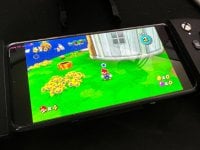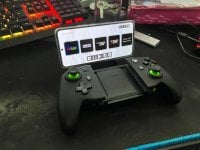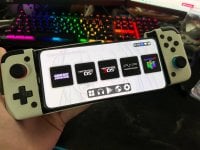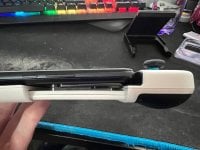Can an Android phone be the perfect emulation handheld?
In my time writing for the site, I’ve seen a huge number of handheld devices with a stark focus on emulation. You have companies like Anbernic and Retroid standing at the forefront with devices tailor made for retro gaming, with others like RetroFlag giving you stylish shells to breathe new life into a Raspberry Pi you might have lying around. I love having a device that just has its single purpose and does it well, and I rated Anbernic’s RG351MP well for it when I got the chance to cover it last year, but these devices have their limits. Typically capping out at SNES or N64, they’re largely designed for your oldies, leaving those wanting more a bit stuck. Do you throw £200 towards AYN’s Odin? Do you go beyond that and spend £350 on a Steam Deck? Or do you just look in your pocket and use what’s there?
To give you a little background, I’m actually reviewing a phone right now, this being Xiaomi’s new 12T Pro. I was having a fairly good time using it, but after around a week of use, a question popped into my head: what am I going to do with this when I’ve finished my review? The obvious answer would be to use it; it’s new and it’s pretty powerful after all. Having just bought an iPhone earlier this year though, this is something I’d consider incredibly wasteful, so what’s left? Having dabbled in Android emulation but never really going all in and committing a device to it, I figured I’d take the plunge and see just how close I could get to a full gaming handheld experience using what I had.
Getting started is really quite easy. Android is familiar and most of the best emulators are available straight from the Play Store. As a starting point, I downloaded My OldBoy (GBC), MyBoy (GBA), DraStic (NDS), PPSSPP (PSP), M64Plus FZ (N64), and AetherSX2 (PS2). I also went out of my way to download Citra MMJ (3DS) and Dolphin MMJR (GameCube/Wii) from their respective GitHub repos, having positive experiences with those in the past over the versions available on the Play Store. It’s worth noting here that RetroArch is available on Android and a pretty good option if you prefer to have everything in one place. It’s generally not what I look for, but an option all the same. The majority of emulators work fine out of the box, with just AetherSX2 requiring a PS2 bios be dropped in.
Switch emulation is also fairly feasible on Android using EggNS, though the shady DRM and software leaves a lot to be desired. I did manage to install the latest build of Skyline, an open source Switch emulator for Android. While it's not there yet, I'm excited to see what it'll develop into.
Having a SnapDragon 8+ Gen 1 under the hood, the performance from emulation was absolutely stellar. It should go without saying that your oldies run great, but what I really wasn’t expecting was to see 3DS games running at 4x native resolution and at 2x speed. The 2x speed part might seem an odd thing to mention, but having started playing Ocarina of Time 3D randomisers at 2x speed a few months ago, I’ve found it really hard to adjust to how slow the game feels without it. Having that option on a handheld with some really impressive graphics blew me away. But it didn’t stop there, with not only Wii games coming out similarly great, but also PS2. Handheld Shadow of the Colossus, and at 2x internal resolution. I find myself continually baffled by just how far portable technology has come and what it’s now capable of. It’s not all great, and I do want to make that clear. While games do play well in terms of performance, you can generally expect to see significant black bars on either side of the screen when playing anything remotely retro.
This naturally comes down to how phones have been evolving in recent years, with long being the new thin. Coming in at a stellar 20:9 aspect ratio, 4:3 (or 12:9 for an easier comparison) games take up just more than half of the screen. Game Boy and Game Boy Color games are even worse than this thanks to their odd 10:9 aspect ratio that leaves just as much of the screen idle as it does active. This is one area where your experience will vary quite significantly from phone to phone, with me previously having a lot of fun with the Surface Duo’s two 4:3 screens. With 16:9 games the black bars aren’t too much of a problem though, and the additional screen real estate does come in handy for dual-screened systems, so it isn’t all bad.
The games themselves play great, and that’s great, but to stop at just setting up emulators and calling it a day would be to overlook a lot of the frustrations that come with using a phone. What has previously held me back from doing something like this has been the Android UI, and its general lack of support for landscape layouts. To get an experience comparable to a gaming handheld, I’d need something better, and something optimised for controller inputs, since that’s what I’d likely end up using. The answer to this dream just so happened to be an app I’d never heard of: Console Launcher.
Now there are a lot of options when it comes to picking a launcher, with a good chunk of them offering a highly customisable experience to get things working exactly as you’d like. When dabbling in this dark art of Android gaming in the past, I’d given Pegasus a go, but ultimately found it a bit too daunting for my youthful expression. Console Launcher did everything I needed it to. It’s ultimately a Nintendo Switch-like experience, with a home screen containing your favourite apps arranged in a horizontal row, and the rest of your apps available elsewhere. Unlike the Switch though, you get customisation options in terms of app icons and background, as well as a pleasant albeit generic-sounding background audio loop. This did everything I needed it to and frankly just looked great.
There are plenty of launchers out there for fans of RetroArch, but for people like me who just prefer to use Android apps, Console Launcher is something I really do recommend.
There was one final hurdle for me to overcome, and it’s one I think I walked around more than actually getting over. The Android lock screen. While I was able to set a default launcher to appear when the device was unlocked, the lock screen itself was completely stuck being portrait with all the usual phoney bits. Sure you only have to swipe it away, or in the case of this phone, look at it the right way, but it takes away from the seamlessness I was striving for. As a bare minimum, I wanted a lock screen that was landscape like the rest of the experience. I still don’t know if this is possible, but what I did find was a way to disable the lock screen entirely. It’s worth mentioning that if you want to be emulating on your daily driver phone, this is hugely not recommended, since you’re waving pretty much all the security available to you, and letting anybody just pick it up and do what they want. For me this isn’t an issue, but it is worth keeping in mind and being mindful of the things you sign into on the device should you get rid of the lock screen like I did.
With the lock screen now gone and my home screen beautified, I was feeling pretty great. What I have here is an incredibly powerful gaming handheld that isn’t necessarily restricted to emulation. Being subscribed to both services, I figured it’d be a great device to load with GamePass and GeForce Now. I also grabbed the controller-friendly Android games I’d accumulated (Disgaea 1 Complete+, Stardew Valley, Dead Cells and Minecraft to name a few), and on a device like this performed just as well as you’d expect them to.
What really surprised me as the standout feature of using a modern phone as a gaming handheld was just how quickly it could be charged up and ready to go. 17 minutes. From 0 to 100, it takes 17 minutes. Your mileage will vary from phone to phone of course, and the 17 minute figure is from what I would probably call an excessive 120W charging capability. For comparison, it’s only an extra ten or so minutes of charge time for a phone that charges at 65W, but a 30 minute charge is still just as mind-blowing to me having grown up with the GBA SP and living by plug sockets.
Getting the most out of an Android device isn’t entirely free. Looking past the few premium apps I listed earlier in the post, the biggest investment outside of the device itself will undoubtedly be the controller you decide to use with it. This is something you have a huge number of options for, with the cheapest likely being a clip to mount your phone to an Xbox controller you might already own, and the most expensive being some of the more feature-packed mobile-oriented controllers. Having reviewed PowerA’s MOGA XP7-X Plus earlier this year, I had on hand what I would consider to be one of the best controllers for the job. I have used a few others in the past, with the Razer Kishi 2 falling a bit short of expectation in terms of it being bulky and not all that comfortable to hold, and GameSir’s X2 being fantastic but not fitting the 12T Pro because of its camera bump. The XP7-X Plus ended up being a good pick here. It’s quite bulky, but its bulk serves a purpose in making it just feel like an actual Xbox controller, with the phone fitting in the middle. I won’t go into too much detail here since I did review it, but one thing worth noting is its battery. One of its major selling points comes in its wireless charging capabilities and the the internal 2000mAh battery to support it. Due to the 12T Pro not supporting wireless charging, I was just left with a Bluetooth controller that never seemed to run out of charge. It’s magical, and when paired with the 12T Pro’s sub-20 minute charging time, there’s next to no down time in longer gaming sessions outside of a (perhaps healthy) break when the phone battery is low.
Note that on further testing, I entirely lied in the video regarding rumble. It was indeed coming from the phone, but my confusion should demonstrate how reasonably alright it was.
I really do love using the 12T Pro as an emulation titan, but I’m not about to tell you to go out and spend £700 to do the same, plus however much you’d want to pay for a mobile controller (around £80 for the MOGA XP7-X Plus I used). It’s just not realistic. What I have here is probably one of the strongest and most portable emulation setups out there, but going as far as I did really isn’t necessary if you’re just wanting to get the most out of your daily driver. My time with the 12T Pro thus far has really opened my eyes to how great a companion a mobile controller can be, and if you’re an Android user I really do recommend picking one up. If you happen to have last generation’s phone lying around in a drawer, I’d encourage you to scoop it up and see what it’s capable of.
Do you use your phone for emulation, or are you devout to another device? Let me know what you think.










